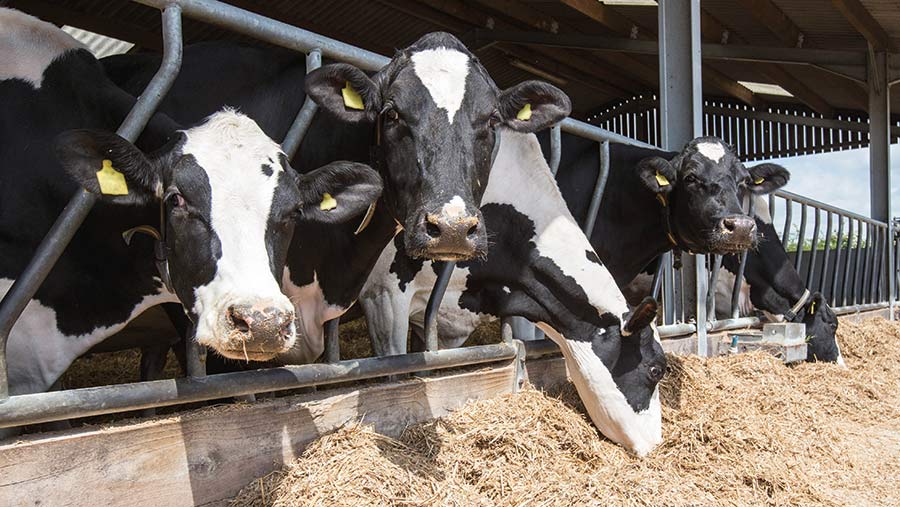5 expert tips on dairy transition management
 © Tim Scrivener
© Tim Scrivener Good transition management is critical to the productivity and profitability of a dairy cow. It is also essential for getting the next generation of the milking herd off to the best possible start.
Duncan Williams, vet nutritionist at Mole Valley Farmers, says while there is so much risk during transition, there is also a lot of opportunity.
“Every single farm can have transition success. There is so much work that goes into it; there’s a lot of physical and emotional labour. But when you get it right, the results are going to set you up for the rest of that cow’s season and for generations to come,” he says.
Conversely, poor transition management can be costly. Dealing with sick animals, losing cows from the herd, reduced production and poor fertility are all expensive, both financially and in terms of workload.
See also: Mastitis control key for dairy herds as cost inflation bites
Mr Williams also highlights the environmental effects of reduced efficiency of production.
“The effect of disease and lost productivity on carbon footprint has not yet been quantified, but the fundamental of it is that any time we have waste, we are going to increase the carbon footprint of the milk we produce,” he says.
He suggests the aim should be to have at least 85% of the herd getting through the calving period without any issues – and that still leaves room to improve.
Any farm-specific strategy should be created with input from the vet or nutritionist, he says.
Data collection
“The most common issue we get on farm is actually that we don’t have enough good-quality data to understand what’s going on,” says Mole Valley Farmers’ Duncan Williams.
“If there is a problem, we can figure out what’s going wrong if we get the right data going into recording systems in the first place.”
He says any milk-recording agency can take disease information from the farm records and digitalise it for ease of analysis. Vets can often do the same. He chooses to use software called Uniform-Agri.
His overall advice for transition success falls into five areas:
1. Focus on intakes
- Ensure intakes are high for the 28 days before calving
- Intakes for a close-up (three weeks or less off calving) Holstein cow should be hitting 13kg dry matter (DM)/day
- Make sure feed is available, fresh and smells good, with roughage chopped well (less than 50mm chop length)
- At calving, move cows to an appropriate milking diet as soon as possible
2. Balance rations
- Rations should be balanced for calcium, protein and energy
- A close-up diet should include a good-quality protein
- Consider a dietary cation-anion difference (DCAD) diet for close-up cows, where salts are balanced to regulate calcium absorption
- Ensure there is sufficient calcium in the post-calving diet
3. Minimise stress
- Before calving, try to reduce stressors such as competition, heat, movement, mixing and diet change. Any stress can cause a drop in feed intake
- Avoid overstocking – allow one bed a cow in the dry and fresh pens
- Feed trough space should be a minimum of 60cm a cow, and preferably 75cm
- Provide clean water at a trough space of 10cm a cow
- Avoid movement in the 10 days before calving
- Ideally, dry cows should be moved to their close-up ration at least four weeks before their due date. Alternatively, consider a single, suitable ration for the whole dry cow period
4. Offer a ‘fresh cow picnic’
- Offer freshly calved cows a couple of big buckets of warm water. Research has shown warm water can increase milk yield, compared with cold
- While not essential, that water can include electrolytes
- Take a wheelbarrow full of total mixed ration, optionally topped with some concentrate, into the calving pen to make it readily available
- This provides the cow with what she needs, but also instills the ethos on farm that these cows need to be treated “like queens”
5. Separate fresh and sick cows
- Try to keep your most infectious cows apart from your most vulnerable (freshly calved) cows
- If possible, pen them separately and keep a distance between them
Key performance indicators
1. Production
Ask yourself: Are significant numbers of cows not reaching the herd target within early lactation?
Target: This will vary between cows and heifers, and depend on the management and breed of the herd. Cows should be getting up to a decent level of production within a month of calving
Tip: Plotting a scatter graph of milk yield against days in milk can reveal problem cows
2. Herd removals in early lactation
Ask yourself: How many cows are leaving the herd within 60 days of calving?
Target: Less than 5%, and ideally below 3%
Tip: Exclude any removals due to other factors and focus only on those that should have been good milking cows, but are affected by transition-related issues.
See also: Ketosis in dairy cows: Cause, symptoms and prevention
3. Fertility and disease
Ask yourself: Is the herd struggling with poor fertility and variable submission rates? Is there a high level of disease?
Transition-related disease includes the obvious health problems such as milk fever, retained afterbirth, displaced abomasums, ketosis and mastitis. But it can also include lameness, because stress during that time can change the way tissue is laid down in the feet.
Targets:
- Milk fever – less than 5%
- Retained placenta – less than 5%
- Displaced abomasum – less than 5%
Tips:
- Fertility issues can often be traced back 60 days to transition management. This time coincides with when the follicles for the next pregnancy are starting to mature
- A lot of mastitis in the first two months of lactation is dry period-related, so housing needs to be optimised to reduce contamination, and stress must be minimised
